SAIC, Singaporeans Challenge BAE For Marine Corps ACV: Tests To Begin
Posted on
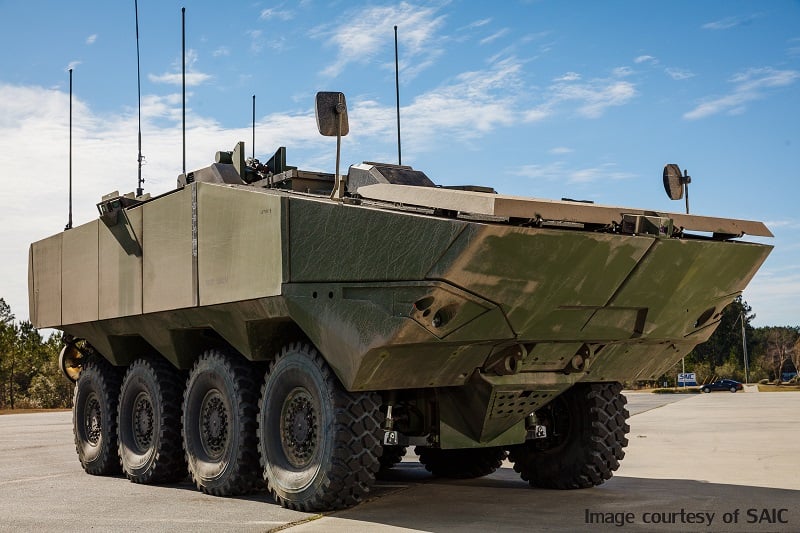
Terrex 2, the SAIC / ST Kinetics contender for the Marines’ Amphibious Combat Vehicle.
An upstart odd couple has challenged armored vehicle giant BAE for the right to build the Marine Corps’ swimming tank. One is Singapore’s ST Kinetics, maker of the Singapore Armed Forces‘ amphibious Terrex vehicle. The other is McLean, Va.-based SAIC, best known as a service contractor, which is working with the Singaporeans to build a bigger, more powerful Terrex 2 for the Amphibious Combat Vehicle competition.
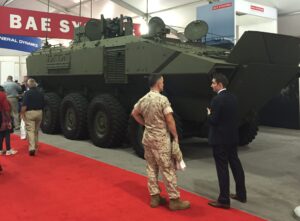
BAE’s competing proposal for the Amphibious Combat Vehicle, derived from the Italian IVECO SuperAV
They’re up against BAE Systems, a global arms maker whose US arm alone employs 32,000 people, twice SAIC’s entire worldwide payroll. BAE has built every Marine amphibious armored vehicle since 1941. Its York, Pennsylvania factory also builds the Army’s Bradley family of tracked combat vehicles, from the workhorse M2 troop carrier/tank destroyer to the new Armored Multi-Purpose Vehicle (AMPV) to the upgraded M109 Paladin howitzer. For ACV, BAE is offering an upgrade of the Italian SuperAV, the latest member of a family of wheeled armored vehicles in long service with the Italian armed forces and built by IVECO, the military arm of legendary automaker Fiat.
The Pentagon’s a long, long way from Singapore, and SAIC doesn’t own a factory. Why are they even in this race?
“Had it been a (traditional) multi-year developmental program, you probably wouldn’t have seen SAIC,” said 20-year SAIC veteran and senior VP Tom Watson. But instead, he told me, “they skipped over an R&D phase and a lengthy development phase, going away from what they tried to accomplish on EFV (Expeditionary Fighting Vehicle), and they basically put out a solicitation that said, ‘hey, industry, what’s available in the commercial market place?'”
Badly burned by the cancellation of the water-skiing tank known as EFV, the Marines decided in 2014 to set their sights a little lower. Instead of a revolutionary “high water speed” design capable of skimming the waves at 25 knots (29 mph), the Marines asked industry for an amphibious fighting vehicle that matched the seven-knot water speed of its existing, BAE-built Amphibious Assault Vehicle but offered superior mobility and protection on land. To avoid another multi-year, multi-billion-dollar development debacle, the Marines also asked for off-the-shelf vehicles (which in practice meant non-US vehicles), modestly modified to meet US requirements.
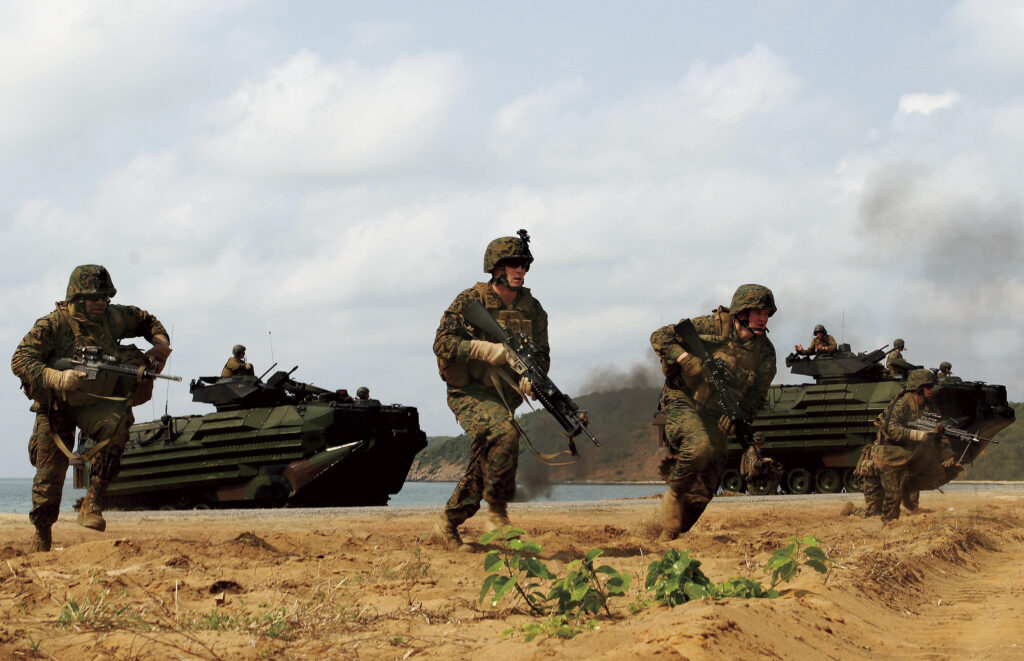
Marines will have to rely on the current Amphibious Assault Vehicle (AAV) show here to carry them ashore for years to come, until the Amphibious Combat Vehicle (ACV) enters service.
“The nature of this acquisition was such that it was geared very nicely, very neatly toward an integrator and not necessarily only reserved for a traditional OEM (Original Equipment Manufacturer),” Watson said.
“SAIC is a traditional services company,” he told me frankly. “That’s our DNA — but we’ve got a substantial amount of experience in systems integration and more specifically in vehicle systems integration. The biggest example is SAIC’s role in fitting electronics for C4I (Command, Control, Communications, Computers, & Intelligence) onto tens of thousands of Mine Resistant Ambush Protected trucks, but the company has also won a contract to upgrade 396 of the Marines’ current BAE-built Amphibious Assault Vehicles.
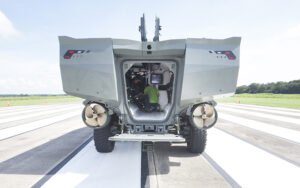
Rear view of the Terrex 2, showing the blast-resistant, seagoing V-shaped hull.
“MRAPs were an existing vehicle in which we integrated the requirements of the various customers,” said Bernie Ellis, SAIC’s ACIV program manager and a retired Army colonel himself. The AAV upgrade is similar, essentially rebuilding the old vehicle. For ACV, he said, guess what, “we’re taking an existing vehicle and upgrading it to meet Marine Corps requirements.”
That existing vehicle is in service by the “hundreds” with the Singaporean Armed Forces, Watson said, as well as being built under license in Turkey as the Yavuz. The original Terrex as-is meets about 80 percent of the Marines’ requirements for ACV, Watson said. SAIC and ST Kinetics then worked together on the 100 percent solution, the Terrex 2.
The Terrex 2 ACV for the Marines can handle a maximum weight 25 percent higher than the original Singaporean Terrex (33 tons vice 26), and it carries 14 passengers and crew instead of 13, with 33 percent more horsepower (600 vice 450) to move the added burden easily, according to SAIC and ST Kinetics factsheets. The upgraded machine has many of the latest protections against mines and roadside bombs. A double-V hull channels the blast away from the armored crew compartment, inside which troops sit in individual shock-resistant seats with footrests to keep shockwaves from breaking their legs.
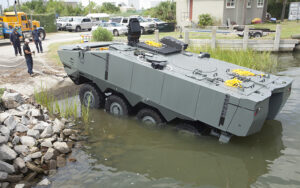
Terrex 2, the SAIC/ST Kinetics contender for the Marines’ Amphibious Combat Vehicle.
Just as important to the Marines is mobility over water. The original Terrex was designed to swim through the shallows, but with additional flotation tanks, its larger hull, and the more powerful engine, the Terrex 2 can swim ashore from an amphibious assault ship. “We’re very, very confident that we can deploy from the well deck of a ship (that’s) 12 nautical miles off shore,” Watson said. Terrex 2 can do so even in the relatively choppy waters known as Sea State 3, and without making the Marines too seasick to fight on arrival, he said. Once on land, the Terrex 2’s automotive system is upgraded to handle a wider range of terrain than the tropical original, including rocky deserts.
The Terrex 2 also has room to grow, said Ellis. If the Marines want to add a 30-mm cannon — as on the Army’s Stryker — or an Active Protection System to stop anti-tank missiles, both under consideration for future upgrades, the vehicle can accommodate the new equipment without become overloaded or unbalanced.
The SAIC-ST Kinetics team and BAE-IVECO are now delivering 16 vehicles apiece to the Marines for over a year of competitive testing. The Marine Corps will make its final decision around July 2018.
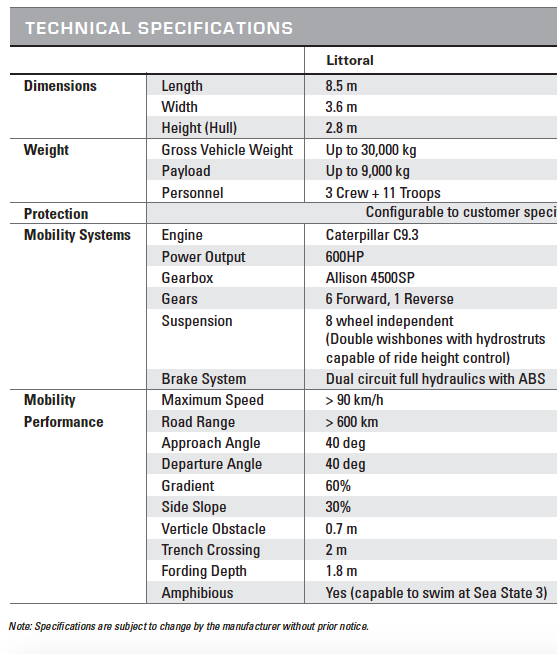
Terrex 2 spec sheet (ST Kinetics)
Subscribe to our newsletter
Promotions, new products and sales. Directly to your inbox.
